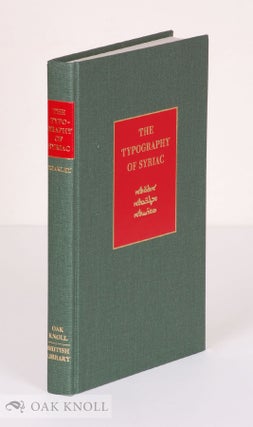PREFACE I
For students of typography
When I first expressed interest in the typography of Syriac more than thirty years ago, I was referred to the books of Talbot Baines Reed and Stanley Morison, each of which has a short section on Syriac. I think it was even intimated that between the two of them the subject was just about covered. It was, however, immediately clear to me that they had made mistakes out of ignorance of the language and script, and it was not too long before I started to realize how much more extensive was the subject than either of these authorities suggested. Still, it was another matter to write something that would supersede them. I started a file and slowly added to it as I got sight of more Syriac printing. I also was able to acquire some actual founts of type from Oxford and Cambridge when the university presses were shedding their letterpress equipment in the 1980s. In 1993 I moved to Harvard University and got the chance to see many more Syriac books in the collections of Houghton, Widener and Andover-Harvard libraries; and this opportunity has, more than anything, enabled me to bring the project to publication at last.
Syriac types were made by the same punch cutters and typefounders who made other types, and a good deal of the history in the present study can be read in abstraction from anything to do with the Syriac language or script just as any typographical historian may benefit from the recent publications of Alan Crown on Samaritan and Fiona Ross on Bengali. A reader who wishes to go further and learn something about the Syriac writing system may pick up the basic facts from the Introduction below, specifically §2; but the only prerequisite for using the rest of the book is the awareness that there are three varieties of Syriac script (estrangela, serto, and Eastern).
For all the length of time that I have been at work on this study, much information that ought to be here has escaped me. Archival and published sources about types are rare, and when external evidence fails, as it usually does, what can be read from the internal evidence of the print itself is limited. This state of affairs obtains not only with early types, but right through the nineteenth century, and it is at its worst for types made in the Middle East and India. If I was ever to finish this book, I could not wait on the chance that more data would come my way. It will be a pleasure to me if the subject interests other scholars who have different language skills and opportunities, and if they will correct and fill in what I have had to leave here in an unsatisfactory state.

